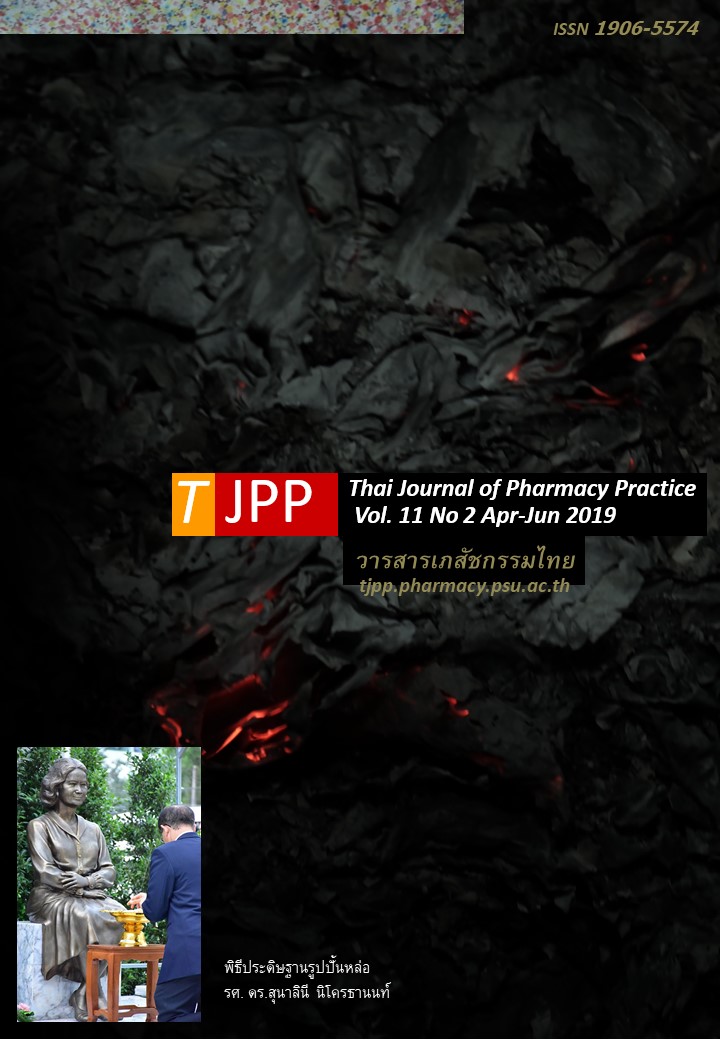การระบาดของผลิตภัณฑ์สุขภาพที่ไม่เหมาะสมและเหตุการณ์ไม่พึงประสงค์ ในผู้ป่วยโรคเรื้อรังเขตชายแดน อำเภอเวียงแก่น จังหวัดเชียงราย
Main Article Content
บทคัดย่อ
วัตถุประสงค์: เพื่อสำรวจการระบาดของผลิตภัณฑ์สุขภาพที่ไม่เหมาะสม และการเกิดเหตุการณ์ไม่พึงประสงค์ (adverse events หรือ AE) ในผู้ป่วยโรคเรื้อรังเขตชายแดน อำเภอเวียงแก่น จังหวัดเชียงราย วิธีการ: การศึกษานี้เป็นการวิจัยเชิงพรรณนาแบบภาคตัดขวาง ตัวอย่างคือผู้ป่วยโรคเรื้อรังอายุ 15 ปีขึ้นไป จำนวน 292 คนที่เลือกจากการสุ่มอย่างง่ายจากฐานข้อมูลผู้ป่วยโรคเรื้อรังของโรงพยาบาลเวียงแก่น ผู้วิจัยออกเยี่ยมบ้านและสัมภาษณ์ตัวอย่างรายบุคคลด้วยแบบสอบถาม ผู้ช่วยวิจัย 16 คนที่เป็นอาสาสมัครสาธารณสุขประจำหมู่บ้าน (อสม.) ทำหน้าที่เป็นล่ามภาษาสำหรับชนเผ่าต่าง ๆ ข้อมูลที่เก็บได้แก่ลักษณะประชากร ชาติพันธุ์ ผลิตภัณฑ์สุขภาพ ได้แก่ ยาและผลิตภัณฑ์เสริมอาหารที่ใช้หรือเคยใช้ ประเภท ภาษาของฉลาก และ AE ที่เกิดขึ้น ผลการวิจัย: ตัวอย่างโรคเรื้อรังส่วนใหญ่เป็นเพศหญิง (174 คน หรือร้อยละ 59.9) อายุเฉลี่ย 62.65±12.18 ปี เป็นโรคความดันโลหิตสูง 211 คน (ร้อยละ 72.3) เป็นชาวพื้นเมืองล้านนา 100 คน (ร้อยละ 31.4) รองลงมาคือชาวเขาเผ่าม้ง (74 คนหรือร้อยละ 25.3) ตัวอย่าง 40 คน มีประสบการณ์การใช้หรือเคยใช้ยาแผนปัจจุบันที่เป็นยาอันตราย และยาควบคุมพิเศษที่กระจายในชุมชน (40/292, ร้อยละ 13.7; 95%CI 10.0-18.2) ชาติพันธุ์ที่พบการใช้มากที่สุดคือชาวเขาเผ่าม้ง 37 คน (37/40, ร้อยละ 92.5) การศึกษาพบฉลากยาที่เป็นภาษาจีนและภาษาเวียดนาม ชนิดยาที่เคยใช้มากที่สุดคือ เด็กซาเมทาโซน อซิเตท 0.75 มิลลิกรัม ร่วมกับ ไพร็อคซิแคม 10 มิลลิกรัมที่มีชื่อการค้าและฉลากยาเป็นภาษาจีนจากตัวอย่าง 17 คน (17/40, ร้อยละ 42.5 ) การศึกษาพบ AE ในตัวอย่าง 5 คน (5/40, ร้อยละ 12.5 95%CI 4.2-26.8) โดยทุกรายมีอาการบวมตามร่างกาย การศึกษาพบการใช้ยาแผนโบราณที่ไม่เหมาะสมในตัวอย่าง 9 คน (9/292, ร้อยละ 2.3 95%CI 1.4-5.8) ชาติพันธุ์ที่พบการใช้มากที่สุดคือชาวเขาเผ่าม้ง 4 คน (4/9, ร้อยละ 44.4) และพบฉลากยาสมุนไพรที่เป็นภาษาพม่า ยาแผนโบราณที่เคยใช้มากที่สุด คือ ยาน้ำสมุนไพรเถาวัลย์เปรียงผสมโสม 4 คน (4/9, ร้อยละ 44.4) เกิด AE ขึ้น 1 คน (1/9, ร้อยละ 11.1 95%CI 0.3-48.2) เกิดภาวะ Cushing ‘s syndrome บวมตามร่างกาย ระดับน้ำตาลในเลือดสูง ไตวาย หลังจากใช้ยาผงสมุนไพรไทย ส่วนผลิตภัณฑ์เสริมอาหารพบการใช้ 11 คน (11/292, ร้อยละ 3.8 95%CI 1.9-6.6) และเกิด AE 1 คน (1/11, ร้อยละ 9.1 95%CI 0.2-41.3) คือ เกิดอาการวิงเวียนศีรษะและอาเจียน สรุป: การศึกษาพบความไม่เหมาะสมของการบริโภคยาทั้งยาแผนปัจจุบันที่เป็นยาอันตรายและยาควบคุมพิเศษ รวมทั้งผลิตภัณฑ์เสริมอาหารในอำเภอเวียงแก่น ทั้งนี้มีผลิตภัณฑ์จำนวนหนึ่งที่มีฉลากเป็นภาษาจีน ภาษาเวียดนาม และภาษาพม่า และพบ AE ที่มีความรุนแรง ชาติพันธุ์ที่พบการใช้ผลิตภัณฑ์เหล่านี้มากคือชาวเขาเผ่าม้ง ดังนั้นควรมีมาตรการต่าง ๆ และจัดตั้งเครือข่ายเพื่อเฝ้าระวัง และหาแนวทางในการแก้ไขปัญหาเหล่านี้ให้ลดลงไป
Article Details
ผลการวิจัยและความคิดเห็นที่ปรากฏในบทความถือเป็นความคิดเห็นและอยู่ในความรับผิดชอบของผู้นิพนธ์ มิใช่ความเห็นหรือความรับผิดชอบของกองบรรณาธิการ หรือคณะเภสัชศาสตร์ มหาวิทยาลัยสงขลานครินทร์ ทั้งนี้ไม่รวมความผิดพลาดอันเกิดจากการพิมพ์ บทความที่ได้รับการเผยแพร่โดยวารสารเภสัชกรรมไทยถือเป็นสิทธิ์ของวารสารฯ
เอกสารอ้างอิง
2. Kiatying-Angsulee N, Prasertsuk S. What happen at the border?: steroid situations and popular hazardous drugs. Thai Drug Watch 2016; 8: 3-24.
3. Saramon P. Development of safety monitoring network and inappropriate drug problem management in border districts: Consumer protection network Lai Ngao District, Wiang Kan. Chiang Rai province [online]. 2015 [cited Jan 30, 2018]. Available from: www.thaihealthconsumer.org/wp-content/uploads/201 7/07/Primary_Pharm_2015.pdf
4. Booddawong B, Kiatying-Angsulee N, Wanleepong K, Boonmanus L, Kadsomboon O, Dokbua J, Pratom nam J, et al. Sources and distribution of unlawful medi cines in 8 provinces of Thailand: to inform the public policy change. Isan Journal of Pharmaceutical Sciences 2016; 11 Suppl: S260-8.
5. Network of consumer protection in Sisaket. Srisaket Province Public Health Office. Distribution of inappro priate controlled drug in the community and survey the products abuse in Srisaket. Sisaket: Srisaket Province Public Health Office; 2014.
6. Assantachai P. Drug-related problem in elderly [online]. 2014 [cited Jan 30, 2018]. Available from: www.si.mahidol.ac.th.
7. Soisrichay P. The consumption of health products in patients with diabetes mellitus, Kangsanamnang sub district. Nakhon Ratchasima [online]. 2018 [cited Dec 20, 2017]; Available from: tci-thaijo.org/index.php/IJP S /article/view/7598/6574.
8. Kongwong R. The screening of steroids uses without medical indication in patients with chronic disease at Warinchamrab district, Ubon Ratchathani. Ubon Rat chathani: Ubon Ratchathani Public Health Office; 2014.
9. Plengchai S. Prevalence of adverse events form drug and health products in patients with chronic diseases and community in Selaphum, Roi-Et. Isan Journal Internal Medicine 2015; 11 Suppl: S33-42.
10. Plengchai S. Interventions for inappropriate distribu tion of drugs in communities. Roi-Et: Health Consu- mer Protection Program; 2011. Report No.:52-00-0360/52-12.
11. Food Bureau. Food Act BE. 2522, public health minis terial regulation, declaration and other related regula tions [online]. 2014 [cited Dec 20, 2017]. Available from: 203.157.72.106/fulltext2/word /17654 /2.pdf.
12. Naranjo CA. Busto U, Sellers EM, Sandor P, Ruiz I, Roberts EA, et al. A method for estimating the prob ability of adverse drug reactions. Clin Pharmacol Ther 1981; 30: 239-45.
13. Asipong S. Health product use behavior with no medical indications among patients with chronic diseases at Rasi Salai, Sisaket province. Thai Journal of Pharmacy Practice 2014; 7:105-13.
14. Ruenruay S, Saokaew S. Situation of medicines and dietary supplements in the health provider board region 3. Thai Journal of Pharmacy Practice 2017; 9: 225-35.
15. Sringern-Yuang L, Hongvivatana T, Pradubmook P. Village drug provision profile in community. Health System Research Journal. 1994; 2: 182-91.
16. Chuengsatiansup K. Drugs with community, social and cultural dimensions. 3rd ed. Nonthaburi: Bureau of Social and Health Research; 2010.
17. Tongyoung P. Rural pharmacy society with inappro priate drug management routes in the community. Thai Drug Watch 2013; 5: 3-5.
18. Prasertsuk S, Thanmaneesin K, Ariyanuchitakul C. Fluidity of steroids problem and policy suggestion in Thailand. Isan Journal Internal Medicine, 2016; 11 Suppl: 245-59.


